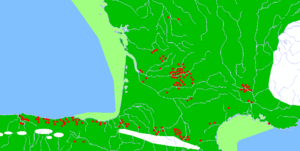Cave of Chufín facts for kids
 |
|
| Location | Rionansa (Cantabria), Spain |
|---|---|
| Coordinates | 43°17′26″N 4°27′29″W / 43.29056°N 4.45806°W |
| Official name: Chufín | |
| Type: | Cultural |
| Criteria: | i, iii |
| Designated: | 1985 (9th session) |
| Part of: | Cave of Altamira and Paleolithic Cave Art of Northern Spain |
| Reference #: | 310-007 |
| Region: | Europe and North America |
| Buffer zone: | 16.65 ha (41.1 acres) |
| Official name: Cueva del Chufin y Chufin IV | |
| Type: | Non-movable |
| Criteria: | Monument |
| Designated: | 27 March 2000 |
| Reference #: | RI-51-0010522 |
The Cave of Chufín is an amazing ancient cave located in the town of Riclones, which is part of Rionansa in Cantabria, Spain. This special cave is found where the Lamasón and Nansa rivers meet. Many caves with ancient rock art are hidden on the steep hillsides above these rivers. Chufín is one of these caves. It is so important that UNESCO has added it to its list of World Heritage sites. It's part of a bigger group called the Cave of Altamira and Paleolithic Cave Art of Northern Spain.
Contents
Chufín Cave: A Glimpse into the Past
Discovery of an Ancient Treasure
The Cave of Chufín was discovered by a photographer named Manuel de Cos Borbolla. He was from a nearby place called Rabago in Cantabria. His discovery helped us learn more about people who lived a very long time ago.
Life in the Cave: 20,000 Years Ago
When experts explored Chufín Cave, they found signs that people lived there at different times. The oldest signs show that people were using the cave about 20,000 years ago! Imagine living in a cave so long ago.
Ancient Art and Mysterious Symbols
This small cave holds some incredible ancient art. You can see delicate drawings and paintings of animals. These include red deer, goats, and cattle. The artists drew them in a very simple, almost cartoon-like way.
Besides the animals, many interesting symbols were also found in the cave. One type of symbol looks like "sticks." These stick-like drawings sometimes appear next to the animal paintings. Scientists are still studying what these symbols might mean. They give us clues about how ancient people thought and communicated.
See also
 In Spanish: Cueva de Chufín para niños
In Spanish: Cueva de Chufín para niños
- Art of the Upper Paleolithic
- List of Stone Age art

